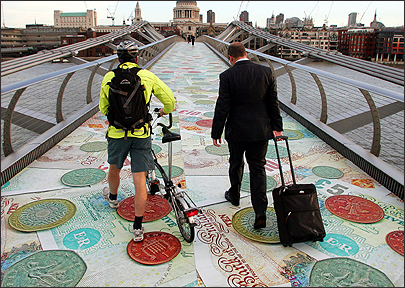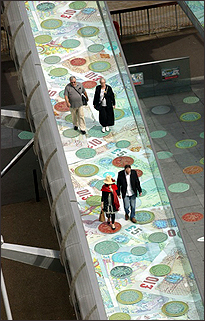MasterCard tried to make a big splash in London this week, with the launch of the U.K. rollout of PayPass, its RFID-enabled payment platform. The card organization plastered London’s Millennium Bridge, which crosses the River Thames, with imitation bank notes, drumming up a buzz about the “path” to a cashless future. Londoners are expected to begin using PayPass cards to pay for small-ticket goods in select shops this fall.
The more than 10 million British commuters who use the Oyster card to pay fares to ride the city’s subway and bus system are already familiar with the ISO 14443-compliant RFID technology used by PayPass. Earlier this year, Visa announced plans for a major European rollout of its payWave cards—which use the same technology as PayPass and Oyster—this fall, beginning with the United Kingdom.

More than five banks, including Barclays, Citibank and HSBC, say they’ll work with MasterCard and Visa to issue the RFID-enabled cards to cardholders. Visa is working with a number of London banks, as well as the city’s public transportation system, to enable the payWave card to double as an Oyster payment card for transit fares.
According to MasterCard, the first U.K. consumers will receive PayPass cards this month, with 5 million expected to be issued by the end of next year. McDonald’s, Eat, Coffee Republic, Yo!Sushi, Krispy Kreme, Books Etc, Threshers and the Science Museum are among the London merchants set to equip payment terminals with the interrogators needed to accept the payment cards. This spring, Visa reported that around 200,000 U.K. consumers will initially receive its cards, and that 2,000 retailers will accept the Visa payWave cards in London (see RFID Payment Platforms Gaining Momentum).
The PayPass and payWave cards will look and function much like the cards currently used by U.K. consumers. The cards employ a contact-based integrated circuit to authenticate transactions based on a cryptographically protected authentication EMV scheme, in which transactions are approved through data exchanged between the card and reader after the cardholder keys a personal identification number (PIN) into the payment terminal. (This contrasts with the payment approval process in the United States, which uses external payment networks to approve transactions, without requiring a PIN.)
In addition to the contact-based chip, each PayPass and payWave card will contain an embedded RFID inlay and a contactless logo printed on it. Consumers will be able to use the RFID function only on transactions totaling £10 ($20.23) or less. To use the RFID function, consumers will hold the card over the reader, then wait for a chirp or beep to indicate a successful transaction. For transactions higher than that amount, they’ll need to insert the card into a reader and key in a PIN.
As a security layer, the banks will require consumers to key in their PINs periodically, thus ensuring that only an authorized cardholder uses that particular card. Oliver Steeley, MasterCard Worldwide’s head of strategy and business planning for developed markets in the region, explains that the cards will have the ability to store the number of contactless transactions performed. Once the contactless function has been used a set number of times—or once a set cumulative transaction amount has been reached—the card will prompt the interrogator to request a PIN before authenticating the contactless transaction. The counter will then reset itself back to zero.
The card could also be set to request a PIN once a certain dollar threshold—£50 ($120), for instance—is reached over a period of consecutive contactless transactions. Either way, each time the card is used to make a contact-based transaction (thus requiring a PIN), the contactless chip’s counter will resets to zero, since the use of a PIN would prove an authorized party was using the card.
The proposed benefit to consumers for using the contactless transaction function would be to expedite transactions, since they would not be required to enter a PIN each time they use it. This week, however, MasterCard released findings from a survey of U.K. consumers, commissioned from YouGov, a British, Internet-based market research firm. The card organization says the results show a growing interest among the British to carry and use less cash.

According to MasterCard, 60 percent of respondents under 25 years old, and 49 percent of those between ages 25 and 34, said they’d use their debit or credit cards more often than cash if the cards were RFID-enabled and could expedite transaction times. Thirty-eight percent said that in five years’ time, they expect to use less cash to pay for goods than at present. When asked to name their top concerns regarding carrying cash, 33 percent identified the risk of their money being stolen, while 34 percent said they feared losing it.
But the introduction of contactless payments has not been welcomed across the board in the United Kingdom. Bank Machine, a U.K.-based ATM operator, argues that by offering consumers a means of paying without a PIN, banks are eroding the value of all the work and money merchants across the nation have spent to establish the EMV payment network and its benefits in fighting payment fraud.
Ron Delnevo, managing director of Bank Machine, fears that contactless, no-PIN cards might become a boon for thieves, who will attempt to steal and use the cards, taking their chances that such will not trigger the PIN request. Another YouGov survey, commissioned by Bank Machine, showed that more than half the respondents believed contactless cards could lead to increased muggings, theft and card fraud.
“We are not raising concerns around the security of the [data sent via the] RF signal,” says Delnevo, “but it’s that the persons using the card does not have to prove who they are.” The notion that society in general is moving way from cash, he states, is a false premise. “Cash is still the most popular medium for buying things [in the United Kingdom]. More than 60 percent of transactions done here last year were done with cash, and that’s why the credit card organizations are working so hard to get rid of cash.” Still, he refutes many of the arguments he has heard against using cash. “Saying that cash is dirty is nonsense—I’ve never met anyone who has gotten ill from handing bank notes.”
Dirty or not, MasterCard has its sights set on using debit and credit cards to supplant cash in the United Kingdom, and thinks contactless technology will help it achieve that goal. “In the U.K., there are 20 billion cash transactions, and the majority of those are under £10,” says Steeley. “We are trying to displace cash transactions.”

